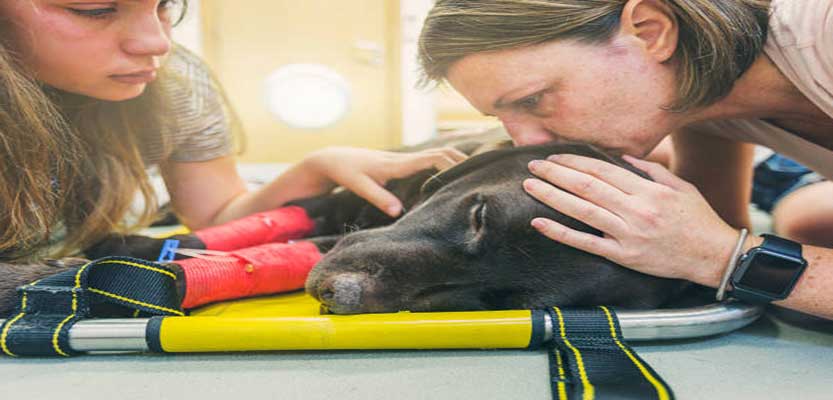
Death is a difficult aspect of life, particularly when it affects a loved one, such as a family member. Typically, this is what happens when a dog spends a significant amount of time inside your home, living by your side. Sometimes, we do not want to see the signs that indicate the best friend of the family is dying. However, it is preferable to do so in order to make his final days more comfortable.
Identifying Death Approaching
It can be difficult to recognize the signs that our dog is dying. To protect themselves, these animals tend to hide them. As a result of their evolutionary process, it is encoded in their DNA that a weak dog can be expelled from the pack or become prey for other animals.
Therefore, the initial step is to determine whether or not your dog is actually lost. Some dogs hide when they are dying, while others become lost and are mistakenly believed to be deceased. Every year, nearly 700,000 dogs are lost in the United States alone, but fortunately there are multiple solutions to this problem and means to find your dog quickly and with minimal effort.
Microchipping is the easiest and most effective way to track your dog. Microchipping is a safe, painless procedure involving the insertion of a small, traceable computer chip beneath the skin of your pet between the shoulder blades. This is a simple procedure performed with a needle by a veterinarian.
Once implanted with a microchip, numerous online platforms provide access to vast networks of local online resources with audiences that can assist you in reuniting with your lost dog. Always ensure that your contact information is current on the microchip, and indicate that your dog is microchipped on any flyers or posters you distribute.
However, a dog suffering from old age or illness will typically exhibit symptoms weeks or even months prior to his final resting place. It is important to be able to identify this impending event so that you can decide whether you would prefer that he not suffer (euthanasia) or whether you would prefer that he remain at home for as long as possible, surrounded by love and comfort.
Signs to Look For:
Your dog ceases to eat
Since eating is one of a dog’s favorite activities, a lack of interest in food is an unmistakable indication that something is terribly wrong. You must take him to his veterinarian, who can determine whether he is merely ill or nearing the end of his life.
Additionally, you can tell because the dog is vomiting. Again, you will need his physician’s confirmation that he is dying and not simply ill, as the latter would be good news for you.
Your dog always appears exhausted
If your dog is not consuming food, he will lack energy. If he is also vomiting, he will lose strength even more rapidly. If your dog is resting in unusual places or is no longer getting up to play, this is a clear indication that something is wrong. When they reach the end, some dogs are unable to even lift their heads. This slow decline may continue for some time, so make sure he is warm and comfortable wherever he prefers to lie.
Your dog has trouble moving throughout the house
Similar to humans, as your dog ages he will lose some of his coordination. However, if he is unsteady and can hardly move from one part of the house to another, he has become too frail and will not survive for long (unless, of course, he is just sick).
Your dog is completely uninterested in everything around him
Dogs are typically aware of their surroundings and responsive to any movement. Your dog’s lack of interest in his surroundings is another indication that he is slowly deteriorating. A dog will withdraw from humans and other animals as they near death. It indicates that its body is beginning to shut down. They typically prefer to be left alone, so try to respect this.
Your pet cannot wait to urinate outside
The bladder is one of the first organs to fail in a dog. He can no longer control himself, so he urinates inside the house. He may even do so while lying in bed. If so, you will need to clean the dog every time this occurs to prevent him from developing sores.
Your dog is waving or twitching.
A dog may experience convulsions during its final stages. It is voluntary if you observe him twitching and lightly trembling. As his body shuts down, he may become progressively colder. Give him a blanket for warmth.
What Can You Do When You Suddenly realise Your Dog Is Starving to death?
As mentioned previously, when your dog is dying, you have the option of euthanasia or keeping him until the end. This decision is individual. Obviously, if the dog is truly in pain, some individuals will believe that it is preferable to end his suffering as soon as possible. Just ensure that you are at ease with your choice before acting on it.
If you choose to keep your dog at home and allow him to spend his final days with you, take care of his needs. Provide comfort wherever he chooses to lie down. Provide him with additional blankets because his body temperature will decrease. If he urinates or defecates, ensure that he and his blankets and cushions are washed immediately so that he remains clean. Finally, show him as much affection as possible by petting him, but respect his need for solitude.
